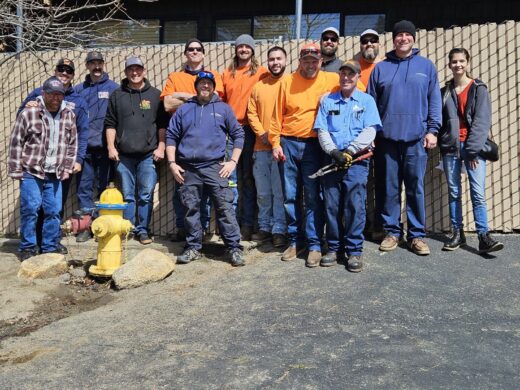As of Friday night, March 15, the Riverside County’s Registrar of Voters
(ROV) had counted nearly 404,200 ballots, or about 30.5% of registered
voters. But the counting will continue into this week. About 2,000
Vote-by-Mail ballots remaining to be counted. These were either damaged
or require further review before being counted. Another 3,200
Conditional Voter Registration ballots remain to be processed. If all
5,000 ballots were counted, turnout would grow by about 0.4%.
The statewide turnout, as of Saturday morning, was 33% with about
287,000 ballots to be counted.
Turnout tended to be greater in the smaller counties, such as 60% of
Sierra’s 2,000 voters. Ten other counties had turnout greater than 50%.
However, only two — El Dorado and Marin — had more than 100,000
registered voters. Of the other eight, only Nevada County had more than
35,000 registered voters.
In Los Angeles County, estimated turnout was 29%, in San Diego County it
was 36% and 25% of San Bernardino’s voters cast ballots.
Presidential races
In the Democratic presidential contest, President Joe Biden easily won
the state’s delegates with 89% of the counted ballots. His Riverside
County result of 89.5% is similar.
In the Republican primary, Donald Trump was the victor with 79.2% of the
Republican votes, but he was stronger in Riverside County with 85.1% of
the vote. Nikki Haley was second statewide and in the county.
U.S. Senate
In the contest to replace former Sen. Diane Feinstein, the state’s
voters decided a nominee from each party was their preference to two
Democratic nominees.
Representative Adam Schiff was the top Democrat and Steve Garvey, a
former Los Angeles Dodger, was the top Republican. They will be battling
through the Nov. election.
Statewide, Schiff and Garvey were almost equal. Only 5,500 votes
separated them, out of nearly 7.7 million votes cast. Both Schiff and
Garvey had 31.7%; but Schiff had the higher vote total. The two other
major Democratic candidates were far behind. Katie Porter of Orange
County had 15.3% and Barbara Lee of Oakland could only capture 9.6%.
In Riverside County, Garvey leads with 42.1% of votes counted and Schiff
received 27.8%.
Despite the results for the candidates in the November election for a
full six-year Senate term, Garvey may be a senator before Schiff. Garvey
has the lead in the election to fill the final two months of Feinstein’s
term. He has 44.7% of the vote compared to Schiff’s 26.5%.
U.S Congress
In the race for Congressional District 41, the two November candidates
will again be Republican incumbent Ken Calvert and Democrat Will
Rollins. This was the choice in the 2022 election, which Calvert won.
Tuesday, Calvert again garnered the majority of votes cast with 52.9%
and Rollins collected 38.6%. A distant third was Anna Nevenic with 8.5%
of the votes.
In an early press release, Calvert said, “I’m humbled by the incredible
outpouring of support I’ve received in the early returns so far, which I
am confident will only increase as ballots continue to be counted.”
In response to the primary and anticipation of the fall election,
Rollins released the following statement: “In our first campaign in
2022, we gave Ken Calvert the closest midterm election of his 30+ year
career, and we did it by bringing Democrats, Republicans, and
Independents together who know that Calvert’s self-dealing might be good
for his own bottom-line, but it’s bad for us. This November, we’re going
to flip this seat …”
The November results will be close and may affect which party has
control of the House of Representatives. Many political pundits and
websites have called it very close. The Cook Political Report ranked the
district as a “toss-up. The National Journal included it as one of the
15 House seats most likely to flip this election cycle. Both The
Washington Post and The New York Times have already published articles
about the district’s role in deciding the next House majority.
Congressman Dr. Raul Ruiz, who represents the 25^(th) Congressional
District, which used to encompass the Hill communities, is winning his
primary with 47.5% of the vote. Ian Weeks, a Republican, is second with
20.8% of the vote.
Assembly District 36
Assembly District 36 encompasses parts of three counties — Imperial,
Riverside and San Bernardino. Overall, Republican Jeff Gonzalez leads
the seven candidates to replace incumbent Eduardo Garcia, who retired.
Gonzalez has captured 34.9% of the total district vote. His challenger
in November will be Democrat Joey Acuña, who had 20%. Edgard Garcia,
another Democratic candidate, earned 12.8% of the vote.
In Imperial County, Gonzalez was the leader followed by Acuña. But
fellow Republican Kalin Morse ran second to Gonzalez in San Bernardino
County, where only 897 ballots have been counted.
Gonzalez and fellow Morse collected 46.2% of the total district votes
cast.
In Riverside County, Gonzalez had 38.3% of the votes and Acuña was
second with 18.8% of more than 44,400 ballots cast.
In his prepared statement last week, Acuña said, “While many ballots
remain to be counted, we are in a strong position to advance to the
general election. … If granted the honor of advancing to November, our
focus will remain on bringing people together and setting a
collaborative policy plan for our district’s future.”
Assembly District 47
In another repeat from 2022, incumbent Republican Gregg Wallis will face
Democratic challenger Christy Holstege in November for the state’s
Assembly District 47 seat.
However, in this primary as of Saturday, Wallis had 48.5% and Holstege
trails after leading since primary day with 46.5%. The difference is
about 2,400 votes. The third candidate, Democrat Jamie Swain, got the
balance with 5.1%.
In 2022, it took weeks to determine that Wallis defeated Holstege by 85
votes out of nearly 170,000 ballots cast. As of Saturday morning, about
118,900 ballots were counted.
Holstege gained the majority of Riverside County votes with 50.3%
compared to Wallis’ total of 44.2%. In San Bernardino County, which has
about 25% of the district’s total voters, Wallis had 63.1% of the vote.
His vote lead in San Bernardino County is about 8,000 votes. In
Riverside County, Holstege had about 5,700 more votes in the primary.
In an email to the Town Crier, Wallis commented, "We’re looking forward
to all the votes being counted in the coming days. I'm confident that as
we move on to the general election … I'm truly grateful for the trust
the voters of the 47th District have placed in me, and it's an honor to
serve them in the State Assembly."
In her press releases, Holstege noted, “Today, as we look over the
initial results from last night, I am deeply grateful and humbled by the
outpouring of support from our community. While we know from experience
not to take any win for granted … In 2022, we came tantalizingly close
to flipping this district, and tonight, we've taken another crucial step
forward.”
Riverside Board of Education
In the Trustee Area 4 race (which includes the Hill), Bruce Dennis
easily won reelection with more than 90% of the vote compared to his
challenger Sergei Vinkov.
With a certain victory, Dennis said in an email to the Town Crier,
“Honestly, I'm thrilled to serve another four years and continue to be
part of the great work RCOE is doing, It also allows me to remain on the
Board of Directors of the California School Boards Association, and
continue my advocacy through them.”
Proposition 1
Proposition 1 combines a $6.4 billion bond with changes to the Mental
Health Services Act, initially approved in 2004. These proposals are
intended to provide mental health care and drug or alcohol treatment to
people, including the homeless.
Statewide it appears that Prop 1 may eke out a victory. As of Saturday
morning, 50.1% of ballots voted “Yes.” Its lead is only 19,600 out of
more than 7 million votes.
In Riverside County, the opposition had 53.6% of the counted ballots,
26,500 more votes than its supporters.
On March 12, the opponents issued the following concession statement,
“The vote on Prop. 1 was closer than it had to be, because Prop. 1
itself is much worse than it had to be. We tried hard to get the word
out about the damage this measure will cause. It does not just ‘reform’
the mental health system, it reduces funding for mental health services
by redirecting $1 billion per year. Prop. 1 could be a humanitarian
disaster if it is not well managed. The incredibly narrow approval of
Prop.1 is the voters saying ‘do not let that happen.’”
County supervisors
There were races for two county supervisorial districts — 1 and 3.
In District 3, incumbent Chuck Washington won reelection. By earning a
majority of the votes — 53.5% — he will not have to face a November race
for reelection.
“I’m happy for the win in the Primary because of what I perceive it
means: even with 2 challengers, voters recognize my effort, my character
and my competence,” Washington told the Town Crier. “Secondly, I am
freed up to devote 100% of my time and energy to serving my District as
their Supervisor … I’m ready to get back to work!”
In District 1, incumbent Kevin Jeffries is retiring at the end of his
term. The two candidates on the November ballot will be Richard Roth, a
former state senator, and Jose Medina, a former Assembly member.
However, Medina’s lead over the third-place candidate, Debbie Walsh, is
only 1,200 votes out of a total of 55,700 cast.










